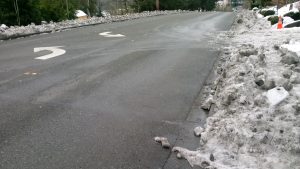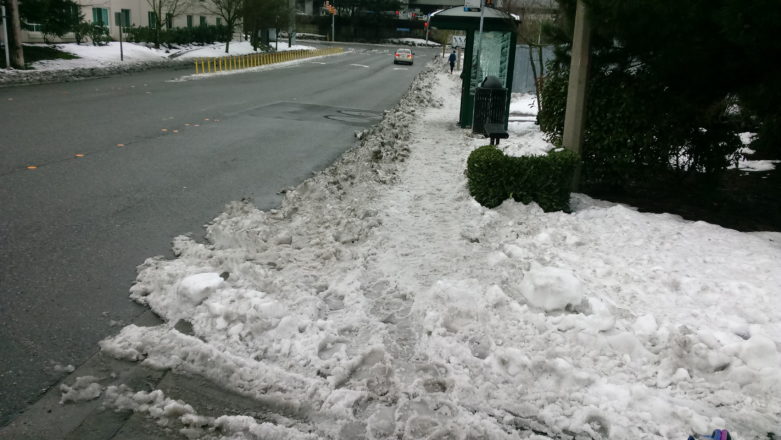Seattle is not built for snow. Despite generally being an accessible city for both disabled and able-bodied individuals, snow and ice throw us into an entirely different ball game. If you are able-bodied, it’s hard enough to manage our steep hills, public transit reroutes, and disruptions in service. For those with mobility issues, this can become an insurmountable problem.
Although property owners are legally required to clear sidewalks, the infrequency of snow in our area means many do not own the supplies needed. This is compounded by plowing, which forces large drifts of snow up onto sidewalks which quickly ice over. Our city has 39 snow plows; a 2012 SeattlePI article questioned if the city has too many snow plows for the amount of snow we get overall. We get significant snowfall every five years or so, making it financially unfeasible for us to have as many snow plows as major cities in the Midwest and East Coast. It is the steep grade of our hills and uneven terrain that affects us more than a lack of preparedness, especially considering how hard it is for us to prepare for an event like Winter Storm Maya that hit us beginning February 3.
“If a sidewalk is icy and I’m driving in my power chair, and I hit a patch of ice, I could very easily veer off the curb into the street or into a ditch or turn over in my chair. There’s a whole list of horrible things that could happen.” – Vanessa Link, UW Student
A spokesperson from WSDOT said that their agency is only able to focus on the basics, clearing major roads and responding to service needs. When asked specifically about how property owners should deal with snow plows covering their sidewalks, the conversation was quickly directed to the line for filing complaints. A spokesperson for the Department of Human Services emphasized that it is the responsibility of disabled people and their caregivers to prepare for a gap in services, not the other way around. Attempts to contact Access led to eventually contacting the media spokespeople for King County, who said they were not able to answer accessibility questions at this time.
Vanessa Link, a production assistant at Rooted in Rights and power-wheelchair user, discussed how a majority of this issue is invisibility. Because we don’t talk about disability accessibility even during good weather, those invisible conversations become all the more pressing during weather like we saw the first two weeks of February. Although Link attends the University of Washington, she lives with her parents on Whidbey Island. When the snow hit, she was unable to leave her home for over two weeks. For those dependent on caretakers and transportation assistance, the risk of not having necessary care keeps individuals housebound. Link had to miss multiple appointments that she depends on for her health. “If a sidewalk is icy and I’m driving in my power chair and I hit a patch of ice, I could very easily veer off the curb into the street or into a ditch or turn over in my chair. There’s a whole list of horrible things that could happen.”
 Rooted in Rights’ lead producer and manual wheelchair user, Clark Matthews, stated “Frankly when it’s snowy and icy, I’m better off just driving as much as I can and avoiding it. Even when streets do get plowed, they often don’t dig out curb ramps.” According to Mathews, uncleared sidewalks and streets go beyond simple inconvenience; often property owners clear a small walkway that may only be accessible for able-bodied persons. “The ADA standards don’t just apply when the weather’s nice, and the ADA guidelines aren’t just niceties,” said Matthews. “The ADA is a civil rights law. When we don’t follow the law because it snows, we’re still violating people’s civil rights. People are being denied equal access and opportunity.”
Rooted in Rights’ lead producer and manual wheelchair user, Clark Matthews, stated “Frankly when it’s snowy and icy, I’m better off just driving as much as I can and avoiding it. Even when streets do get plowed, they often don’t dig out curb ramps.” According to Mathews, uncleared sidewalks and streets go beyond simple inconvenience; often property owners clear a small walkway that may only be accessible for able-bodied persons. “The ADA standards don’t just apply when the weather’s nice, and the ADA guidelines aren’t just niceties,” said Matthews. “The ADA is a civil rights law. When we don’t follow the law because it snows, we’re still violating people’s civil rights. People are being denied equal access and opportunity.”
“The ADA is a civil rights law. When we don’t follow the law because it snows, we’re still violating people’s civil rights. People are being denied equal access and opportunity.” – Clark Matthews, Rooted in Rights
Even as we become more aware of mobility and other needs during times of inclement weather, the sub-population of those with psychiatric disabilities is still remarkably invisible. For those who rely on frequent appointments with providers this kind of event can be extremely disruptive. For those with depression and anxiety, being trapped in the house takes on an entirely different perspective. Although improvements in distance appointments have started evolving, many forms of insurance still only cover in-person appointments, an impossibility for those who physically or emotionally cannot get to those appointments. After interviewing several students with mental health disabilities, a majority of them said that although they technically could have tried to brave public transit, they didn’t feel safe.
The immensity of these issues is created by a combination of snow being infrequent, our city and residents not always being prepared to respond, and the incorrect assumption that disabled persons are a small group. As we learn more about the spectrum of disability we begin to see how large a population we are truly talking about, and that equal access is a right for all. Visibility is the key to creating proactive awareness.
Author

Morgan is a Seattle Central alumni currently attending Oregon State University where she is majoring in Anthropology. In addition to writing, she enjoys painting and linguistics. She lives in a very small house with a very fat cat.







Be First to Comment